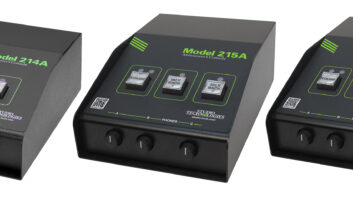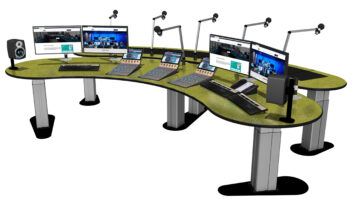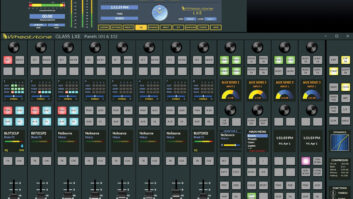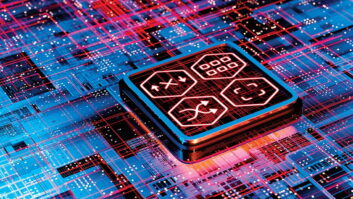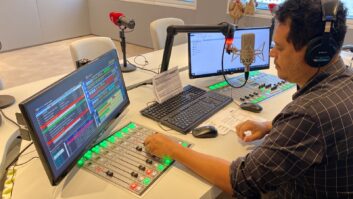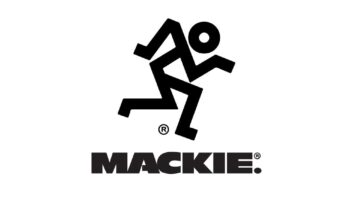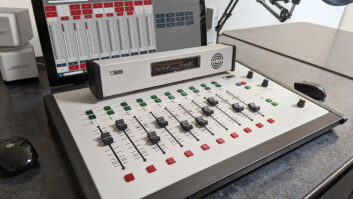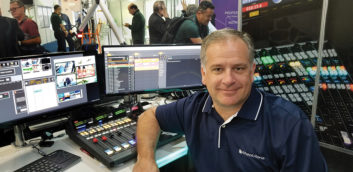
This is part of Radio World’s series exploring trends in radio broadcast consoles.
Jay Tyler is director of sales for Wheatstone Corp. An earlier version of this article appeared in the RW ebook “Trends in Consoles.”
Radio World: What’s notable in how consoles are designed today?
Jay Tyler: They have become “softer.” We still have a physical control surface, with knobs and metering and faders, [but] the actual functions of those buttons have changed.
Where we would normally have a Program button, there might be a Program All or that might be a programmable button to not only put that channel on-air in Program, but it might start a skimmer, it may cue up other microphones in the talk studio.
The physical consoles we’re using are becoming more flexible and more user-defined, rather than manufacturer-designed like their analog counterparts.
A perfect example is Townsquare Media. Traditionally it had been an AoIP customer buying traditional control surfaces that acted like their analog counterparts, as far as the user goes. Well, we’ve done [projects in] Lafayette, La.; Lufkin, Texas — and now Duluth, Minn., where we’re rolling out eight control rooms — with what we call Glass LXE. This is our console that’s not running on Wheatstone surface hardware. It’s talking to a Wheatstone Mix Engine but it’s running on third-party hardware, whether it’s an all-in-one PC or a fancy touchscreen.
Ultimately, that’s where a lot of people are leaning — to save money and to break into the next level, and maybe make that control room look futuristic.
[Read “How to Choose Your Next Radio Console”]
RW: How does virtualization apply to this conversation?
Tyler: In Wheatstone’s world, when you’re virtualizing something you’re running many instances of software. That could be our mixing console, that could be our applications, or that could be our drivers. We consider that at the local level.
So when you hear virtualization, automatically we think, “Okay, we’re going to consolidate PCs and everything we have here locally.” We’re going to virtualize the console. That means it’s going to go on a hard drive somewhere, and it’s going to have a touchscreen interface. When we virtualize studios, this means we’re consolidating our resource locally.
You’re going to hear another term called centralization. Centralization and virtualization go together. This means we’ve got our audio located in one spot in the country, usually on-site at somebody’s property within the organization; and then we’re polling and we’re distributing music.
[Related: “Virtualization and Cloud Come to the Forefront”]
Virtualization is just a consolidation at the radio station. Automation manufacturers were the first ones to virtualize their systems. They didn’t put it in a cloud; they basically put it on a big server with redundant drives and all the security you could ask for.
The other side of virtualization is what we think of as cloud-based services. Everybody wants to save money, we get it; everybody wants to jump on the bandwagon and use Amazon and Google Cloud, etc. People are looking at it, we’ve had discussions with customers about it.
One of the biggest obstacles we’re going to have to overcome is latency. If you were to take all the “stuff” we have in the studio now and put it in the cloud, all of your microphone audio has to go up. Everybody’s microphone would have to go up; arrive at the same time; be mixed; and then be sent back to us at the local market.
We see the automation guys leaning more towards cloud-based services and cloud-based delivery, because latency isn’t such a big deal. I think what you’re going to see initially as an end result is a combination of maybe a virtual studio with a cloud-based automation system being streamed down.
RW: How vibrant is the marketplace for a traditional analog console?
Tyler: You can quote me on this: We sell a lot of analog consoles.
If you’re a small studio and more than 50% of your sources are analog, it makes perfect sense for you to buy an analog console, especially if your transmission chain is analog. At a typical small mom-and-pop station, we’re going to have a couple of analog microphones, an analog telephone hybrid, a couple of channels with automation. We’re probably going to have a consumer CD player.
There’s still nothing wrong with the analog mix engine. In our Audioarts lineup we currently have the 08, the AIR-1, the AIR-4 and the Lightning — from small to bigger mid-market analog offerings.
Some of the advantages of analog? Guys can fix it. People feel comfortable with it. There’s no laptop, no software, no licensing — you own it. When you get an analog console, you’re not going to get an upgrade, it’s just going to do what it does.
How long will analog be around? As long as your analog power amplifier! People can always fix them, you can always get the parts for them. Unless [you have] power supply issues or you’ve spilled something in it, they tend to work.
Wheatstone still services every single analog console we’ve ever sold. That goes back to our recording days.
RW: Other thoughts?
Tyler: If you’re an analog guy and feel comfortable buying analog, all of us manufacturers still do some cool interfaces with the analog. We’ve given you Bluetooth interfaces, we’ve got analog consoles with USB I/O. You can still get some of the advantages of the digital boards out there by picking the right stuff.
RW: But those digital boards sure are pretty powerful.
Tyler: You can control them from anywhere in the world. Most of the digital boards are going to give us a remote interface; so instead of the engineer in Ithaca, N.Y., driving to the radio station in the snow to hit the program button on the monitor module for the jock, they can open up their laptop, log in and soft-select a monitor module and go back to sleep.
Because the digital stuff becomes more technical, it also allows you the benefits of factory support services that all of us offer. With digital we can remote in and do a lot of stuff. We can configure things, we can troubleshoot, and we can do online training. There are big advantages there.





